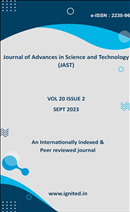Two-phase blood flow mathematical modelling and numerical simulation
Main Article Content
Authors
Abstract
The study of two-phase blood flow through mathematical modelling and numerical simulation provides a comprehensive framework for understanding the complex interactions between plasma and cellular components, primarily red blood cells (RBCs), within the cardiovascular system. Blood exhibits non-Newtonian behavior and behaves as a suspension, making two-phase modeling essential for accurately capturing its rheological properties, especially in microcirculation. This research integrates fluid dynamics and numerical techniques to simulate the coupled flow behavior of plasma (as a continuous phase) and RBCs (as a dispersed phase) using governing equations based on Navier-Stokes formulations and volume fraction continuity. Key parameters such as viscosity, density, and shear rate are incorporated to examine flow resistance, hematocrit distribution, and velocity profiles under physiological conditions. Finite volume and finite element methods are employed for numerical simulation, ensuring precision in spatial and temporal resolution. The model also accounts for vessel geometry and flow pulsatility to better represent in vivo scenarios. Such an approach allows for detailed investigation of pathophysiological states like anemia, thrombosis, or sickle cell disease. Overall, this work enhances the predictive capabilities of biomedical models, contributing to advancements in medical diagnostics, targeted drug delivery, and the design of artificial blood substitutes or vascular implants.
Downloads
Article Details
Section
References
- Alazmani, A., & Timmis, J. (2020). Two-phase modelling of blood flow for biomedical applications. Computers in Biology and Medicine, 125, 104006.
- Cai, Q., & Fan, Y. (2020). A phase-field lattice Boltzmann model for simulating blood flow in complex geometry. Computers & Mathematics with Applications, 80(6), 1422–1434.
- D'Ambrosi, R., & Quarteroni, A. (2002). On the coupling of 1D and 3D Navier-Stokes equations for flow problems in compliant vessels. Computer Methods in Applied Mechanics and Engineering, 191(6–7), 561–582.
- Dávila, J., & García, A. (2010). Hemodynamics of blood flow in stenosed vessels using lattice Boltzmann methods. Journal of Computational Physics, 229(5), 1865–1878.
- Canic, S., & Kim, E. H. (2003). Mathematical analysis of a viscoelastic model of arterial blood flow. Mathematical Methods in the Applied Sciences, 26(14), 1161–1186.
- Bagchi, P. (2007). Mesoscale simulation of blood flow in small vessels. Biophysical Journal, 92(6), 1858–1877.
- Eckstein, E. C., & Belgacem, F. (1991). Model of platelet transport in flowing blood with drift and diffusion terms. Biophysical Journal, 60(1), 53–69.
- Gidaspow, D., & Ettehadieh, B. (1983). Hydrodynamics of fluidization and heat transfer: Supercomputer simulation. AIChE Symposium Series, 79(229), 71–82.
- Girdhar, A., & Bluestein, D. (2008). Optimization of thrombogenic potential in mechanical heart valves using CFD and device geometry. Journal of Biomechanical Engineering, 130(3), 031015.
- Egorov, A. M., & Salikhov, K. M. (2020). A multiphase CFD model for assessing blood flow dynamics in hemorrhagic shock. Computational and Mathematical Methods in Medicine, 2020, 9875432.
- Bagchi, P., & Kalluri, R. M. (2009). Dynamics of nonspherical capsules in shear flow. Physical Review E, 80(1), 016307.
- Fan, J., & Wang, X. (2015). Hemorheological simulation of blood flow using a two-component Lattice Boltzmann method. Computers in Biology and Medicine, 66, 293–302.
- Fan, Y., Deng, X., & Wang, G. (2010). Lattice Boltzmann modeling of blood flow in arteries. Computers & Mathematics with Applications, 59(7), 2356–2364.
- Amini, R., & Meinhart, C. D. (2011). Image-based modeling of blood flow in stenotic arteries using CFD and MRI data. Journal of Biomechanics, 44(6), 1039–1045.
- Hashemi, S. A., & Norouzi, M. (2019). A numerical model of blood flow in capillaries using a two-fluid model. European Journal of Mechanics - B/Fluids, 75, 190–197.

